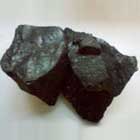
Gilsonite History & General Information
The mineral now know as Gilsonite was
discovered in the early 1860's, but it
was not until the mid-1880's that Samuel
H. Gilson began to promote it as a
waterproof coating for wooden pilings,
as an insulation for wire cable, and as
a unique varnish. Gilson's promotion of
the ore was so successful that, in 1888,
he and a partner formed the first
company to mine and market Gilsonite on
a commercial scale.
Originally, Gilsonite was sold as
"Selects" and "Fines"; the law softening
point ore with conchoidal fracture was
known as "Selects". The higher softening
point ore with a pencillated structure
was known as "Fines". Selects commanded
a higher price than Fines because of its
better purity, good solubility, and
usefulness in the paint, stain, and
varnish industries.
Time and technology have changed this
classification system. Processing of
Gilsonite now removes most of the inert
contaminants and newer, more powerful,
solvents make the higher softening point
grades more interesting to the user.
Today, Gilsonite is graded by softening
point (a rough measure of solubility)
and particle size. All grades carry a
degree of quality far superior to those
first small amounts of crude Gilsonite
marketed in the 1880's.
Gilsonite Technical Information
The information in these pages is
based on laboratory evaluation and field
experience. It is correct to the best of
our knowledge. Recommendations are made
without warranty or guarantee and buyer
assumes all risk and liability.
Gilsonite Physical Properties:
| Test |
Test Result |
Method |
| Color in Mass |
---- |
Black |
| Color in streak or Powder |
---- |
Brown |
| Specific Gravity at 25/25 C |
ASTM-D3289 |
0.8 |
| ASH content, wt% |
ASTM-D3147 |
7.60 |
| Moisture content wt% |
ASTM-D3173 |
0.5 |
| Volatile matter at 900C |
ASTM-D3175 |
62.3 |
| Solubility in cs 2 wt% |
ASTM-D4 |
74.9 |
| Softening point C |
ASTM-D-36 |
160 |
| Penetration |
---- |
3 |
| Flash point |
---- |
380-400 F |
| Fixed carbon |
ASTM-D3172 |
27.5 |
Elemental analysis:
N content , wt%
C content , wt%
H content , wt%
S content , wt% |
ASTM-D5291
ASTM-D5291
ASTM-D5291
Lp-242 0.59 |
74.4
7.3
4.5 |
Other specification according to API or OCMA standards.Gilsonite Molecular Structure:
A variety of sophisticated analytical
tests have been run on Gilsonite to
characterize its unique properties. For
reference, the test methods include
vacuum thermal gravimetric analysis (TGA),
nuclear magnetic resonance (NMR),
Fourier transform infrared spectrometry
(FTIR), vapor pressure osometry (VPO),
high performance liquid chromatography (HPLC),
rapid capillary gas chromatography (RCAP),
and several fractionation techniques.
H/C ratios and NMR analysis indicate the
presence of a significant aromatic
fraction. Most of the aromatics exist in
stable, conjugated systems, probably
porphyrin-like structures that relate to
the geologic source of the product. The
remainder of the product consists of
long, paraffinic chains.
A very unique feature of Gilsonite is
its high nitrogen content, which is
present mainly as pyrrole, pyridine, and
amide functional groups. Phenolic and
carbonyl groups are also present. The
law oxygen content relative to nitrogen
suggests that much of the nitrogen has
basic functionality. This probably
accounts for Gilsonite's special surface
wetting properties and resistance to
free radical oxidation.
The average molecular weight of
Gilsonite is about 3000. This is very
high relative to other asphalt products
and to most synthetic resins. This may
relate to Gilsonite's "semi-polymeric"
behavior when used as a modifying resin
in polymeric and elastomeric systems.
There is some reactive potential in
Gilsonite. Crosslinking and addition
type reactions have been observed.
Gilsonite is known to react with
formaldehyde compounds under certain conditions.
Gilsonite Compatibility
Gilsonite is compatible with
Microcrystalline and Paraffin Waxes,
Petroleum Resins and Oils, Rosins, Tall
Oil Pitch, Vegetable Oils (Linseed,
Soya, etc.), Petroleum Process Oils, and
Petroleum Asphalts.
Gilsonite Compatibility with Commercial Resins
The following is a general guide to the
compatibility of Gilsonite resin in
common film-forming and elastomeric
systems. Because Gilsonite compatibility
can be influenced by variations within a
resin/elastomer class and by other
components in a formulation, it is good
practice to verify Gilsonite
compatibility in the specific formula of
interest.
|